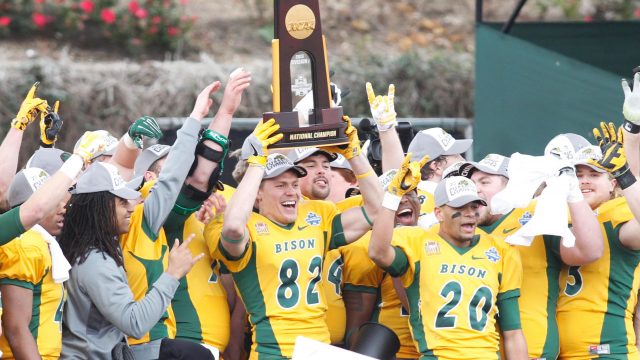Where’s the Evidence That Successful Sports Teams Increase Enrollment at North Dakota Universities?

Jan 9, 2016; Frisco, TX, USA; North Dakota State Bison players hold up the championship trophy after the game against the Jacksonville State Gamecocks in the FCS Championship college football game at Toyota Stadium. North Dakota State won the championship 37-10. Mandatory Credit: Tim Heitman-USA TODAY Sports
I am absolutely delighted at the debate we are having in North Dakota right now over the cost of collegiate sports.
Things might not change much, unfortunately, and it’s clear from my email inbox and social media accounts that even talking about this stuff makes a lot of people angry. But at least we are talking about it, and specifically we’re all acknowledging one very important fact about collegiate sports programs in North Dakota which has been obscured by campus propaganda in the past.
Sports, even the most popular programs, cost big money as they’re operated today.
Sports reporters are even writing about it, and instead of denying it campus leadership and homer editorial writers are now trying to rationalize it.
That’s an important shift in the debate. But there are still some myths to debunk. Such as this one from UND President Mark Kennedy who responded to some of my criticisms of campus athletics in an interview with the Grand Forks Herald.
Kennedy makes an oft-repeated argument from the defenders of campus sports programs, which is that they help market the school and attract enrollment:
Herald: At SayAnythingBlog.com, Rob Port has a post where he says, “At UND, sports programs lost $13.3 million in 2016.” He asks why colleges subsidize any sports at all, given that all of the sports seem to lose money in North Dakota, including men’s hockey at UND. Football apparently loses more money than women’s hockey does.
So, why should UND subsidize intercollegiate sports?
Kennedy: I have said many times and will say many times that sports are the front porch of the university. What that means is that the programs are the “porch” where you invite others onto the property; and once they’re there, they see what’s inside—the wonderful programs that you have, the great campus, the ambiance, the students.
It attracts your future students, in other words. And not just for your face-to-face programs, as it also helps create the brand for your online programs.
I’m working on getting Kennedy on my radio show this week – sounds like maybe Thursday at this point – but for now let’s see if the data backs up those claims.
As a case study let’s look at how the back-to-back-to-back-to-back-to-back football championships at NDSU impacted enrollment there.
It’s a good example. It is probably the most successful run for any campus sports team in state history.
Based on data from the NDSU website (which includes distance education programs) here’s a graph showing fall enrollment numbers for each year going back to 2005. Remember that the NDSU football team went on its championship run from 2011-2015:
From 2010, the year before the first championship, to 2016, the year after the last championship, NDSUs fall enrollment increased just 0.17 percent.
The school added exactly 25 students in enrollment during that time.
How can we rationalize the millions of dollars in financial burdens we put on the backs of students and taxpayers to subsidize collegiate sports by saying they help recruit students when five straight football championships produced pretty much zero enrollment growth at NDSU?
Nothing has stopped NDSU from expanding enrollment. In fact, just a couple of years ago, NDSU President Dean Bresciani was convinced that his school had what it needed for a 25 percent increase in enrollment, and while his critics (including this one) suggested that the school ought to instead focus on student retention and completion, the school certainly could have increased enrollment.
They just didn’t. Maybe sports don’t impact enrollment as much as some would like to think.
At UND the picture is a little less clear cut. We don’t have an easy example like the NDSU football team’s championship run to look at, and the enrollment situation at that school, per the data on their website which goes back to 1997, has been far more dynamic than the one at NDSU:
For reference the men’s hockey team, the premier sport at UND, accomplished
- NCAA championships in 1997, 2000, 2016
- Conference tournament championships in 1997, 2000, 2006, 2010, 2011, 2012
- Conference regular season championships in 1997, 1998, 1999, 2001, 2004, 2009, 2011, 2015, 2016
I see no discernible correlation between hockey team success and enrollment gains.
But maybe there’s data I’m missing.
If so, those justifying big spending on sports programs by suggesting that it benefits the school through increased enrollment ought to make good with the data to support their argument.






